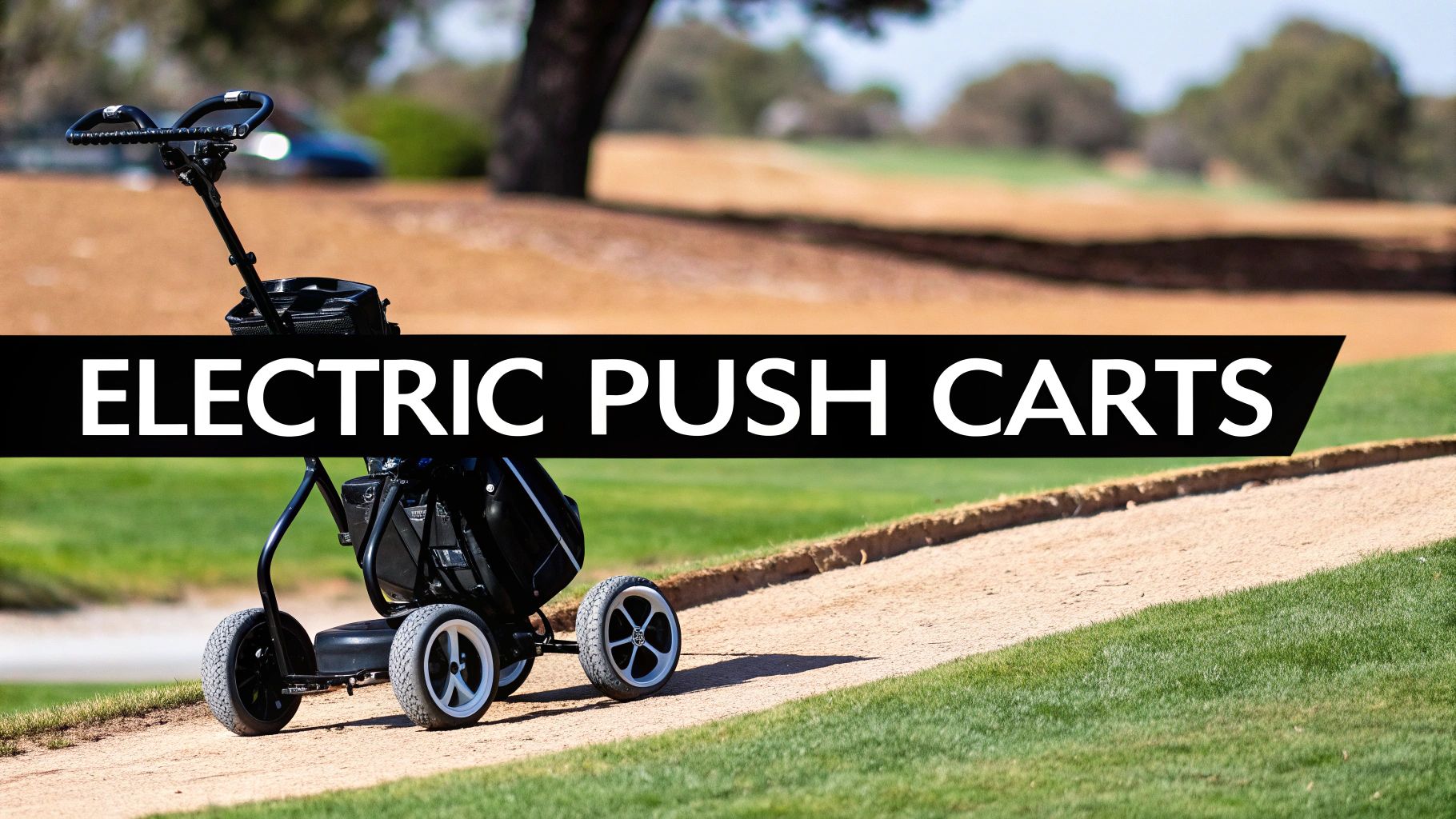If you've been searching for electric push carts reviews golf, you've probably noticed a common thread: they're all about saving your energy so you can sharpen your focus. It's like the difference between rowing a boat across a lake and using a quiet motor—you still steer the ship, but you arrive at your destination ready for action, not wiped out. This simple upgrade is genuinely changing how golfers feel on the course.
Why Electric Carts Are the Modern Golfer's Best Friend
Imagine this: you're walking up to the 18th green feeling just as fresh and energized as you did on the first tee. That's the real magic of an electric push cart. While a standard push cart is definitely better than carrying your bag, you're still doing all the work, especially over a full round.
An electric cart takes over that grunt work, gliding effortlessly across fairways and tackling hills without breaking a sweat. Saving that energy isn't just about comfort; it's a huge strategic advantage. When your body isn't tired from pushing 30-40 pounds of clubs and gear, all that physical and mental energy can go right back into what matters most—your swing.
This visual perfectly captures how an electric cart helps you keep your performance high from start to finish.

The big takeaway here? Finishing strong isn't just a possibility; it becomes the expectation when you aren't physically drained from hauling your equipment all day.
The Tangible Benefits on the Course
The perks go way beyond just feeling less tired. When you let a motor handle the load, you'll often see a real, measurable improvement in your game. Some of the biggest benefits include:
- Sharper Mental Focus: Less physical strain means your mind is free to concentrate on shot selection, reading greens, and managing the course.
- Improved Physical Performance: With more gas left in the tank, your swing mechanics stay consistent from the first drive to the final putt.
- Reduced Risk of Injury: Shoving a heavy cart over uneven ground can put a lot of stress on your back, shoulders, and knees. An electric caddy pretty much eliminates that risk.
An electric cart turns a physically demanding walk into a refreshing one. It keeps your mind on the game, not on the next hill, allowing for a more strategic and enjoyable round.
At the end of the day, using an electric push cart is about playing smarter, not harder. It's a modern tool for any golfer who wants to get the most out of their ability and enjoy their time on the course. To see how these benefits translate directly to a better score, you can learn more about the 5 benefits of electric push carts for golfers in our article.
Understanding the Technology That Powers Your Game
When you start digging through electric push carts reviews golf articles, it’s easy to get lost in all the technical specs. But you don't need an engineering degree to understand what makes a great electric cart. Think of it like buying a new car—you don’t need to be a mechanic, but knowing the basics helps you pick the right one for your lifestyle.
It’s the same with your cart. The whole system boils down to three key parts: the battery, the motor, and the controls. How these three work together determines how far your cart will go, how it handles hills, and just how easy it is to use on the course.
The Heart of the Cart: The Battery
If there's one component that matters most, it’s the battery. It’s the powerhouse of your entire setup. Today, almost every quality cart runs on a Lithium-ion battery, and for good reason. They are worlds away from the old, clunky lead-acid models—much lighter and more compact, making the whole cart easier to lift and store.
A solid Lithium-ion battery will give you enough juice for 27 to 36 holes on a single charge. That means you can play all day without that nagging worry that your cart will die on the 17th green. Of course, getting that kind of performance long-term means taking care of it. For a deep dive, check out our guide to maintaining electric trolley batteries.
Motor Power and Braking Systems
The motor is the muscle. It’s what gets your bag up those steep hills without you breaking a sweat. A powerful, quiet motor is a sign of a quality cart and is one of the biggest differences between entry-level models and premium ones. With a good motor, you'll never have to give your cart an "assist" on an incline again.
But what goes up must come down, and that’s where the braking system comes in. This is a crucial feature for anyone who plays a course that isn't perfectly flat.
- Automatic Downhill Braking: This is a total game-changer. The cart senses it's on a decline and automatically keeps a steady, controlled pace. No more chasing a runaway cart down a hill.
- Electronic Parking Brake: Just as important, this brake locks the wheels in place when you stop on a slope. Your cart—and your expensive clubs—will stay right where you left them.
The best electric push carts make you forget they're even there. They move at your pace, stop when you stop, and handle any terrain so you can focus completely on your next shot.
Essential Electric Push Cart Features Comparison
To help you decide what features are non-negotiable for your game, we've broken down some of the most important ones. This table compares the standard options you'll find on most good carts with the premium features that take performance to the next level.
| Feature | Standard Option (Good) | Premium Option (Better) | Why It Matters |
|---|---|---|---|
| Battery Type | Lithium-ion (27 holes) | Extended-Range Lithium-ion (36+ holes) | A longer-lasting battery means less charging and zero range anxiety on the course. |
| Control System | Handle-mounted speed dial | Remote control with "Follow Mode" | Remote and follow features offer a true hands-free experience, letting you walk freely. |
| Downhill Braking | Manual brake | Automatic Downhill Control | Automatic braking prevents your cart from running away on steep declines. |
| Parking Brake | Foot or hand-activated manual brake | Electronic Parking Brake | An electronic brake provides a more secure hold on hills, preventing any movement. |
| Frame Material | Durable aluminum | Lightweight, aircraft-grade aluminum or carbon fiber | Lighter materials make the cart easier to lift, transport, and maneuver. |
Think about the courses you play most often. If they're hilly, features like automatic downhill control and an electronic parking brake move from "nice-to-have" to essential. If you value convenience above all, a remote with follow mode might be at the top of your list.
Smart Features and Remote Controls
Beyond the core mechanics, modern electric carts are getting smarter. Remote controls are incredibly popular, letting you send your cart to the next tee while you walk to the green. The most advanced models even have a "follow" mode, using sensors to trail you like a loyal caddie, creating a completely hands-free walk.
This kind of tech is becoming the new standard. Market analyses show that smart features like GPS, digital displays, and even regenerative braking are what set the best carts apart. You can find more insights on the growing electric golf cart market on PolarisMarketResearch.com. When you know what the technology does, you can look at any cart and see exactly how it will—or won’t—improve your time on the course.
Reviews of the Top Electric Golf Carts

Sifting through electric push carts reviews online can feel like searching for a needle in a haystack. There are countless models, all promising to be the best. To cut through the noise, we put the top contenders to the test where it actually matters—out on the course.
Instead of just listing specs, we’re telling the story of who each cart is truly for. We've looked at everything from how quickly you can get it set up to how it handles a soggy, uphill lie. This is a real-world look at the pros and cons to help you find the perfect match for your game.
The All-Terrain Powerhouse for Hilly Courses
If your home course has more ups and downs than a roller coaster, you know that power and stability aren't just nice-to-haves—they're essential. One model consistently left the others in the dust on tough terrain. It’s built with a high-torque motor that makes you forget you’re even on an incline.
Its wide wheelbase and a smart anti-tip wheel give you the confidence that it won’t topple over, even on awkward sidehills. We also loved its long-range battery, which easily lasted for 36 holes on demanding layouts. It's a bit heavier than its compact cousins, but that's a small price to pay for a caddy that's practically glued to the ground.
Best For: Golfers who regularly tackle rugged, hilly courses and need a cart that prioritizes raw power and unshakable stability.
The Compact and Convenient Urban Golfer's Choice
For those of us short on storage space, a clunky, oversized cart is a non-starter. We found one model that is an absolute dream for anyone with a small car trunk or a crowded garage. It folds down into a shockingly small package with a simple, one-step mechanism.
Crafted from aircraft-grade aluminum, it's light enough to lift without a second thought. But don't let its size fool you—it’s packed with features. You get a snappy remote control, a trustworthy electronic parking brake, and enough battery to get you through 27 holes on most courses. Its slim profile is perfect for zipping around a busy clubhouse.
Best For: Players with limited storage, golfers who travel, or anyone who just wants a hassle-free setup and breakdown.
Matching a Cart to Your Playing Style
At the end of the day, there is no single "best" cart for everyone. The right choice is the one that fits so seamlessly into your game that you barely notice it's there.
"The ideal electric cart is one you don't have to think about during your round. It should respond effortlessly to your commands, handle the terrain flawlessly, and let you focus entirely on your game, not your gear."
To find your perfect partner on the links, ask yourself a few key questions:
- What kind of courses do you play? If you’re playing mountain golf, you need power. If your course is flat and walkable, a lighter, more nimble option might be better.
- Is a remote control a must-have? The freedom of walking down the fairway hands-free is a game-changer for many. If that’s you, look for a cart with advanced remote and follow features.
- What’s your budget? Prices for electric carts can vary wildly, from around $600 to over $1,500. Nailing down your budget first will make your search much easier.
By answering these questions, you can move past the generic marketing claims and zero in on the features that will actually improve your time on the course. It’s the surest way to pick a cart that you’ll be happy with for years to come.
Walk onto just about any golf course today, and you'll see a quiet takeover in progress. The sputtering, noisy gas carts that once ruled the fairways are giving way to their whisper-quiet electric cousins. This isn't just a passing fad—it's a real shift in how we experience the game.
The reasons behind this change are as practical as they are profound. Let's be honest, the peaceful atmosphere of a golf course is one of its best features. Electric carts keep it that way. Their silent operation gets rid of the disruptive engine noise that can mess with a player's focus, making sure the only sounds you hear are the satisfying thwack of a great shot and the birds in the trees.
Beyond the peace and quiet, there’s a massive maintenance advantage. Gas engines are needy. They demand oil changes, new filters, and constant tune-ups. Electric carts? They have far fewer moving parts, which means way less upkeep and downtime for course managers and private owners alike.
Why Electric is Winning the Fairway
This move toward electric power isn't happening by accident; it's a direct response to what today's golfers and course operators are looking for. It goes beyond just noise and maintenance—it's about creating a more sustainable and enjoyable version of the sport we love. The key drivers are clear:
- Eco-Friendly Performance: With zero emissions, electric carts are simply the greener choice. They help courses shrink their carbon footprint and appeal to players who care about the environment.
- A Better Round of Golf: The smooth, quiet ride of an electric cart just makes for a more pleasant day. It lets you focus on your shots and soak in the natural surroundings without a rumbling engine in your ear.
- Smarter Operational Costs: For golf clubs, the savings on fuel and maintenance across an entire fleet add up fast. Switching to electric is just good business.
The widespread switch to electric carts boils down to a simple truth in the golf world: what’s better for the player’s experience and what’s better for the course’s bottom line are finally the same thing.
The market data backs this up completely. A recent analysis of the North American golf cart market showed that nearly 60% of all new carts sold in 2023 were electric models. That’s a massive signal of where golfer preferences are headed. This transition is being driven by real-world benefits like quieter rounds and lower maintenance, which pop up again and again in owner reviews. The trend is especially strong in golf communities where peace and sustainability are top priorities.
If you want to dig into the numbers yourself, you can check out the North American golf cart market findings on MarketDataForecast.com.
At the end of the day, choosing an electric cart isn't just a purchase; it's a forward-thinking investment that lines up perfectly with where the game of golf is headed.
How to Choose Your Perfect Electric Caddy

Alright, you've got the lay of the land on key features and top models. Now it's time to make the final call. Picking the right electric caddy isn’t about chasing the one with the most bells and whistles; it’s about finding the one that perfectly syncs up with your game.
Think of it like choosing a club for a tough lie. You wouldn't pull out a driver from a deep bunker, and you definitely shouldn't get a lightweight caddy if your home course is basically a mountain. This last step is all about looking at your own game and asking the right questions to make sure your investment pays off for years to come.
Your Personal Buying Checklist
To cut through the noise of all the electric push carts reviews out there, start with a few simple questions about how you play. Answering these honestly will steer you straight toward the features that will actually make a difference for you.
- How Hilly Is Your Home Course? If you’re playing on mostly flat ground, you don't need to overthink motor power. But if your course has serious inclines, a high-torque motor and automatic downhill braking are non-negotiable. They're about safety as much as performance.
- Is a Remote Control Essential? The luxury of a remote with a "follow me" mode is hard to beat for a true, hands-free round. If walking to your ball totally unburdened sounds like a dream, then this feature should be at the top of your list. If you're fine with simple, direct control, a handle-mounted system will work just fine.
- What's Your Realistic Budget? Electric caddies can run you anywhere from around $600 to over $1,500. Setting a firm budget right from the start helps you zero in on models that give you the best bang for your buck, so you don't end up paying for features you'll never use.
A great electric cart should feel like a natural extension of your game—quietly doing its job in the background so you can focus on yours. The goal is to find a model that solves your specific on-course challenges.
And for those who already love their current push cart? You don't have to start from scratch. Our guide to a golf push cart electric conversion kit shows you how to add motorized power without buying a whole new caddy.
Looking Beyond the Obvious Factors
Once you've matched a cart's specs to your playing style, it's time to think about the long game—what it's actually like to own the thing. These often-overlooked details can be the difference between a purchase you love and one you regret.
1. Warranty and Customer Support
A solid warranty tells you the manufacturer has confidence in its product. Look for at least a 12-month warranty covering the frame, motor, and battery. Just as crucial is the company's reputation for customer support. A quick scan of reviews will tell you how helpful they are when things go wrong.
2. Brand Reputation and Reliability
Established brands usually have a proven track record for making gear that lasts. While a new company might have a great product, a brand with years of positive feedback gives you an extra layer of confidence that you're making a smart buy.
3. Cost of Replacement Parts
Down the road, you'll eventually need to replace parts like the battery or wheels. Before you commit, do a quick search for the cost of a replacement battery for the model you're eyeing. A cart that seems like a bargain upfront isn't such a great deal if the replacement battery costs a fortune. By thinking through every angle, you can make a choice that'll improve your game for countless rounds.
Got Questions? We've Got Answers
Even after scrolling through tons of electric push carts reviews golf articles and guides, it's natural to have a few lingering questions. After all, you want to be sure you're making the right call for your game. We get it. That’s why we’ve put together some straight-to-the-point answers for the most common questions we hear from fellow golfers.
Think of this as the final piece of the puzzle. We’ll cover the big stuff—battery life, portability, and whether it’s really worth the money—so you can feel totally confident in your decision.
How Long Do the Batteries Really Last?
This is usually the first thing on everyone's mind, and for good reason. Nothing’s worse than the thought of your cart dying on you mid-round. The good news is that most modern electric push carts are powered by high-quality lithium-ion batteries designed to go the distance, easily lasting 27 to 36 holes on a single charge.
Of course, that can change depending on the course. If you’re playing a super hilly track or have a bag loaded with extras, you might use a bit more juice. The best habit to get into? Just plug it in and charge it fully after every round. That way, you're always starting fresh with more than enough power for your next game.
Are Electric Push Carts a Pain to Lug Around?
Not at all. The people who design these carts know that no one wants to wrestle with their gear in the parking lot. The vast majority of electric carts are built for quick, easy transport. Most feature a simple one or two-step folding mechanism that shrinks them down to a surprisingly compact size.
This smart design means they’ll slide right into just about any car trunk without a fuss. Getting it set up for the first time is just as simple—usually, all you need to do is pop on the wheels and give the battery its initial charge. You can go from unboxing to fairway-ready in minutes.
Is an Electric Push Cart Actually Worth the Money?
While the upfront cost is obviously more than a standard push cart, most golfers who play regularly find the investment pays for itself in pure enjoyment and better scores. The real win is how much physical energy you save. That energy translates directly into a more powerful, consistent swing, especially when you hit the back nine.
An electric cart lets you enjoy all the health benefits of walking the course without the fatigue that can tank your game. For anyone who plays often, the long-term value is a no-brainer.
Plus, when you add up what you'd spend on rental cart fees over a season, it can easily run into hundreds of dollars. So for anyone who plays regularly, tackles hilly courses, or just wants to take the strain off their back and shoulders, the answer is a big, loud yes—it’s absolutely worth it.
Ready to make every round easier? The Caddie Wheel converts your existing push cart into a powerful electric caddy in minutes, giving you the freedom to walk the course without the work. Discover the Caddie Wheel today!


Share:
Your Guide to Electric Golf Caddy Remote Control
Mastering the Best Handicap Golf System for Your Game